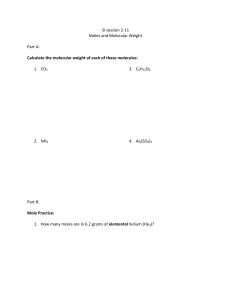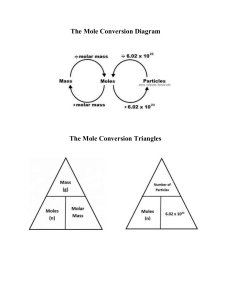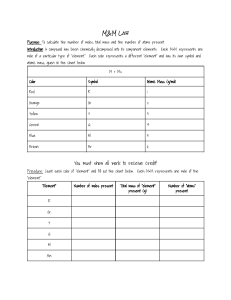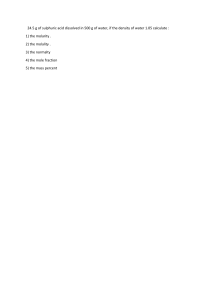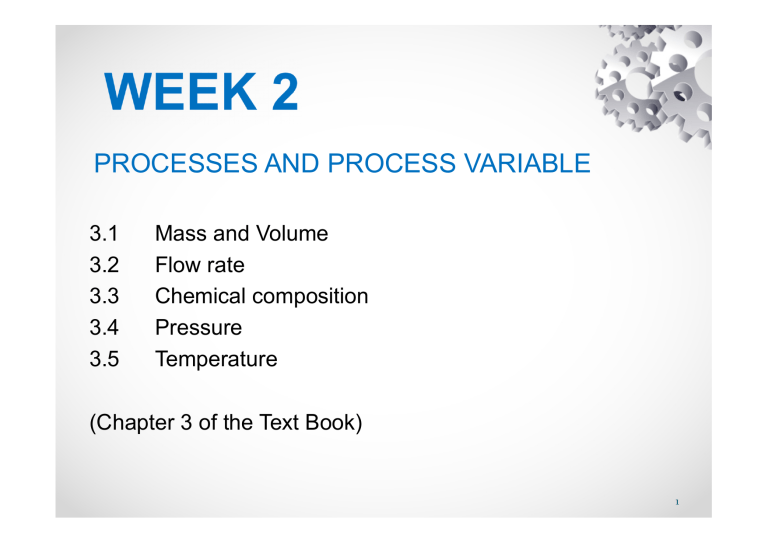
PROCESSES AND PROCESS VARIABLE 3.1 3.2 3.3 3.4 3.5 Mass and Volume Flow rate Chemical composition Pressure Temperature (Chapter 3 of the Text Book) 1 Week 2 : Part 1 3.1 3.2 3.3 Mass and Volume Flow rate Chemical composition (Chapter 3 of the Text Book) 2 3.1 Mass and volume q Density – mass per unit volume ( kg/m3, g/cm3, lbm/ft3, ect.) q Specific volume - inverse of density (m3/kg, cm3/g, ft3/lbm, ect.) q Specific gravity - ratio of the density of substance (ρ) to the density of reference (ρref); (SG = ρ/ρref) SG 20 o C / 4 o C 0 .6 * SG of subtance at 20oC with reference to water at 4oC is 0.6. Refer TABLE B.1 for SG of selected compounds. Commonly used ρref : H 2O ( l ) ( 4 o C ) 1 . 000 g cm 3 1000 kg 3 m 62 . 43 lb m 3 ft 3 3.1 Mass and volume (cont') Try the following questions: qTest your self (page 37) qExample 3.1-1 qExample 3.1-2 4 3.2 Flow rate - Mass and volumetric flow rate Density = mass/volume = mass rate/volume rate m m v v Density of a fluid can be used to convert a known volumetric flow rate to the mass flow rate q Test your self (page 39) 5 3.2 Flow rate - Measurement Flowmeter is a device to read flow rate in a process line. Commonly used flowmeter – rotameter and orifice meter (pls refer Fig 3.2.1) 6 3.3 Chemical composition 3.3a Moles and molecular weight Atomic weight – the mass of atoms of certain element (example: C = 12) Molecular weight - sum of the atomic weight of elements in the molecule of the compound Example: atomic weight of oxygen (O) = 16 molecular weight of oxygen (O2) = 16x2 = 32 Refer Table B.1 for the molecular weight (MW) value of other compounds 7 3.3 Chemical composition 3.3a Moles and molecular weight Types of mole: Gram-mole = g-mole = mol kg-mole = kmol Ib-moles ton-moles Types of molecular weight: Note as M or MW kg/kmol g/gmol Ibm/Ib-moles Example: Carbon monoxide (CO), its MW is 28. Hence, 1 mol of CO contains 28 g = 28 g/mol 1 kmol of CO contains 28 kg = 28 kg/kmol 1 Ib-mole of CO contains 28 Ibm = 28 Ibm/Ib-mole 1 ton-mole of CO contains 28 tons = 28 tons/ton-mole 8 3.3 Chemical composition 3.3a Moles and molecular weight (cont') MW can be used as a conversion factor that relates the mass and the number of moles of the compounds Example : To convert 34 kg of ammonia (NH3) to kmol (MW = 17) 34 kg 1 kmol 2.0 kmol NH3 17 kg Please try the following questions: q Example 3.3-1 q Test your self (page 42) 9 3.3 Chemical composition 3.3b Mass and mole fraction and average molecular weight Mass fraction : Mole fraction : xA yA mass of A kg A gA Ibm A or or total mass kg total g total Ibm total moles of A kmol A gmol A Ib - moles A or or total moles kmol total gmol total Ibmole total Average molecular weight : M y 1M 1 y 2 M 2 ...... 1 x x2 1 ..... M1 M2 M Please try the following questions: q Example 3.3-2 q Example 3.3-3 q Example 3.3-4 10 3.3 Chemical composition 3.3b Mass and mole fraction and average molecular weight Mass fraction can be converted to mole fraction by: 1. Assuming basis of calculation a mass of the mixture (eg. 100kg) 2. Use the mass fraction to calculate mass of each component 3. Convert the mass of each component to mole using its MW 4. Calculate the total mole of the mixture 5. Take the ratio of the moles of each component to the total mole of mixture 6. Hence mole fraction can be determined. Example 3.3-3 : Basis 100 g (mtotal) Component i Mass fraction xi (g/g total) Mass (g) mi = xi*m(total) MW Mi(g/mol) Moles ni =mi(g)/Mi(g/mol) Mole fraction yi=ni/n(total) O2 0.16 16 32 0.50 0.15 CO 0.04 4 28 0.14 0.04 CO2 0.17 17 44 0.39 0.12 N2 0.63 63 28 2.20 0.69 Total 1.00 100 3.28 1.00 11 3.3 Chemical composition 3.3c Concentration Mass concentration : mass of component per unit volume (g/cm3, kg/in3) Molar concentration : mole of component per unit volume (kmol/m3) Molarity : gmoles of solute per liter of solution (2 molar solution A = 2 mol A/liter solution) Please try the following question: q Example 3.3-5 12 3.3 Chemical composition 3.3d Part per Million and Part per Billion Part per million (ppm) Part per billion (ppb) Use to express trace species in gas or liquid Example: 15 ppm SO2 in air = 15 parts per million SO2 Every million moles of air contains 15 moles of SO2 Mole fraction of SO2 in air = 15 x10-6 Please try : Test your self (page 47) 13 END OF WEEK 2: PART 1 Week 2 : Part 2 3.4 3.5 Pressure Temperature (Chapter 3 of the Text Book) 15 3.4 Pressure 3.4a Fluid pressure and hydrostatic head q Pressure - ratio of a force to the area on which the force acts. Unit - N/m2, Pa (SI), dynes/cm2, Ibf/in2 or psi q Fluid pressure – (F/A) where F is the minimum force exerted on the frictionless plug in the hole (A) to keep the fluid from emerging 16 3.4 Pressure 3.4a Fluid pressure and hydrostatic head q Hydrostatic pressure – When; # the P of the fluid at the based of the column # the force that exerted on the base divided by the base area A Where; Force (total) = force top surface + weight of fluid in the column Hence; Po P = Po + ρgh h ρ P 17 3.4 Pressure 3.4a Fluid pressure and hydrostatic head q Hydrostatic head (head of fluid) The height of the column of the fluid exerted the pressure at its base and the pressure at the top is zero Hence; P = ρgh where Po = 0 Po h Please try the following questions: q Example 3.4-1 q Example 3.4-2 ρ P 18 3.4 Pressure 3.4b Atmospheric pressure, absolute pressure and gauge pressure Pabsolute = Pgauge + Patmospheric Patmospheric = 1 atm (standard pressure) Pgauge = pressure from pressure-measuring devices Pabsolute = Pgauge when (Patm = vacuum) Standard atmospheric pressure: 760 mmHg, 1 atm Please try Test yourself (page 50) 19 3.4 Pressure 3.4c Fluid pressure measurement Categorizes of pressure-measurement devices: q Elastic-element methods – Bourdon tubes, bellows or diaphragms q Liquid-column method – manometers q Electrical methods – strain gauges Strain gauge Bourdon gauge – suitable to measure fluid pressures from vacuum to 7000 atm 20 3.4 Pressure 3.4c Fluid pressure measurement Manometer give more accurate measurement (pressure < 3 atm) Barometer when P1 = Patm (absolute pressure @ sealed end) P1 P1 P1 P2 P2 P2 ρ1 sealed-end opened-end Types of manometers 21 3.4 Pressure 3.4c Fluid pressure measurement P1 General manometer equation: P1 + ρ1gd1 = P2 + ρ2gd2 + ρfgh when fluid 1 and 2 are the same, ρ1 = ρ2 = ρ Manometer variable P2 ρ2 d2 d1 ρ1 ρf Differential Manometer equation: P1 - P2 = (ρf - ρ)gh If either fluid 1 or 2 is gas at moderate pressure, part ρgd can be neclected Manometer formula for gasses: P1-P2 = h Please try the following equations: q Test yourself (page 53) q Example 3.4-3 22 3.5 Temperature Temperature mearsuring devices: o resistance thermometer o thermocouple o pyrometer o thermometer Temperture scales: o Celsius o Fahrenheit o Kelvin o Rankine 23 3.5 Temperature Temperature conversion & conversion factor: T(K) = T(oC) + 273.15 T(oR) = T(oF) + 459.67 Kelvin (K) Rankine (R) T(oR) = 1.8T(K) T(oF) = 1.8T(oC)+32 Conversion factor for temperature interval: 1.8 o F 1.8 o R 1o F 1o C , , o , o 1K 1 C 1 R 1K Please try the following equations: q Test yourself (page 55) q Example 3.5-1, 3.5-2 and 3.5-3 24 END OF WEEK 2: PART 2 • Try exam questions Dec 2016 (Q1 & Q2) 26

